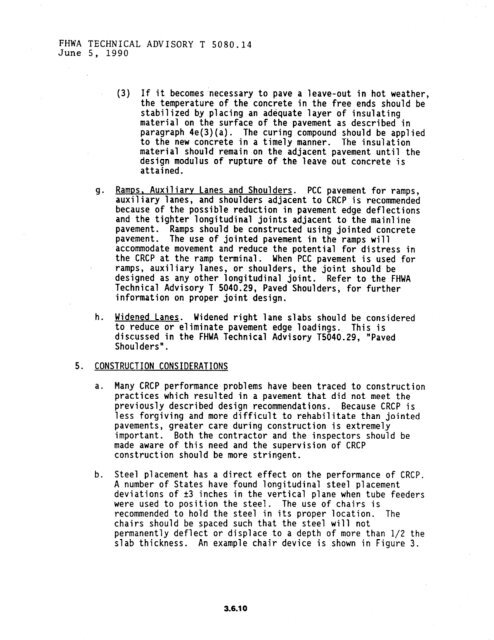chapter 3 rigid pavement - DOT On-Line Publications - Department ...
chapter 3 rigid pavement - DOT On-Line Publications - Department ...
chapter 3 rigid pavement - DOT On-Line Publications - Department ...
Create successful ePaper yourself
Turn your PDF publications into a flip-book with our unique Google optimized e-Paper software.
FHWA TECHNICAL ADVISORY T 5080.14<br />
June 5, 1990<br />
(3) If it becomes necessary to pave a leave-out in hot weather,<br />
the temperature of the concrete in the free ends should be<br />
stabilized by placing an adequate layer of insulating<br />
material on the surface of the <strong>pavement</strong> as described in<br />
paragraph 4e(3)(a). The curing compound should be applied<br />
to the new concrete in a timely manner. The insulation<br />
material should remain on the adjacent <strong>pavement</strong> until the<br />
design modulus of rupture of the leave out concrete is<br />
attained.<br />
9. Ramps. Auxiliary Lanes and Shoulders. PCC <strong>pavement</strong> for ramps,<br />
auxiliary lanes, and shoulders adjacent to CRCP is recommended<br />
because of the possible reduction in <strong>pavement</strong> edge deflections<br />
and the tighter longitudinal joints adjacent to the mainline<br />
<strong>pavement</strong>. Ramps should be constructed using jointed concrete<br />
<strong>pavement</strong>. The use of jointed <strong>pavement</strong> in the ramps will<br />
accommodate movement and reduce the potential for distress in<br />
the CRCP at the ramp terminal. When PCC <strong>pavement</strong> is used for<br />
ramps, auxiliary lanes, or shoulders, the joint should be<br />
designed as any other longitudinal joint. Refer to the FHWA<br />
Technical Advisory T 5040.29, Paved Shoulders, for further<br />
information on proper joint design.<br />
h. Widened Lanes. Widened right lane slabs should be considered<br />
to reduce or eliminate <strong>pavement</strong> edge loadings. This is<br />
discussed in the FHWA Technical Advisory T5040.29, "Paved<br />
Shoulders".<br />
5. CONSTRUCTION CONSIDERATIONS<br />
a. Many CRCP performance problems have been traced to construction<br />
practices which resulted in a <strong>pavement</strong> that did not meet the<br />
previously described design recommendations. Because CRCP is<br />
less forgiving and more difficult to rehabilitate than jointed<br />
<strong>pavement</strong>s, greater care during construction is extremely<br />
important. Both the contractor and the inspectors should be<br />
made aware of this need and the supervision of CRCP<br />
construction should be more stringent.<br />
b. Steel placement has a direct effect on the performance of CRCP.<br />
A number of States have found longitudinal steel placement<br />
deviations of 23 inches in the vertical plane when tube feeders<br />
were used to position the steel. The use of chairs is<br />
recommended to hold the steel in its proper location. The<br />
chairs should be spaced such that the steel will not<br />
permanently deflect or displace to a depth of more than l/2 the<br />
slab thickness. An example chair device is shown in Figure 3.<br />
3.6.10
















